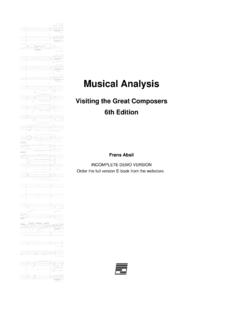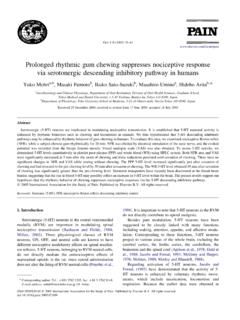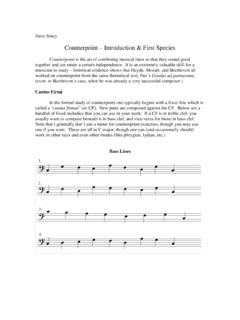Transcription of Arranging by Examples - Frans Absil
1 N .. c .. c n . # . c . # . c f . c . f c # . a2. Arranging by Examples c n The Practical Guide to b c . f Jazz and Pop Orchestra Arranging c . f c Third Edition f . n c . c . # n . c .. # . Frans Absil . c . b .. c b .. c . c c c b .. # b 13/ #11 b 13/# 11.. E7 E7.. c |.. c n n n . b n . c b c b . c . y y y y y y y Y. c .. f c .. Suspended cymbal f . n c n . n . 14. Colophon This e-book is a practical guide to Arranging for jazz and popular music orches- tra. This document has been created with the public domain LATEX computer type- setting program. Diagrams were created using the LATEX picture environ- ment and the PSTricks package. Musical Examples were created using the MakeMusic Finale 2011 music nota- tion software. Score Examples were imported into the document as Encapsu- lated Postscript (EPS) files, using the graphicx package. All photographs by the author.
2 The navigation links (printed in blue) in the Adobe Acrobat Reader file (the pdf-file) were created using the hyperref package from the LATEX distribu- tion. Free demo/trial version: This incomplete demo/trial version e-book is offered free of charge. Order and buy the full version of this music analysis E-book. See the website for payment instructions. Arranging by Examples : The Practical Guide to Jazz and Pop Orchestra Arranging , Third Edition, Frans Absil c 2005-2014 Absil , the Netherlands. URL Website: All rights reserved. No part of this publication may be reproduced or transmitted in any form or by any means, electronic or mechanical, including photocopying, recording, or any information storage and retrieval system, without prior permission in writing from the Author. ii Contents List of Figures vii List of Tables xi Preface xiii I Preparations 1. 1 Introduction 3.
3 What you will find in this book .. 3. Arranging Techniques .. 3. The approach: Examples discussed in detail .. 4. Notation in the book .. 4. Assembling the arrangement .. 5. What you will not find in this book .. 5. No MIDI files available .. 5. Ready to get hands dirty? .. 5. 2 Instrumentation 7. The range of musical instruments .. 7. Instrument groups .. 7. Orchestra sections and balance .. 11. Rhythm section .. 11. Saxophones .. 12. Woodwinds .. 15. Brass .. 16. Strings .. 20. Percussion .. 24. Unfamiliar acoustic instruments .. 25. Electronic instruments .. 27. The score .. 28. Vertical staff order .. 29. Various forms of the score .. 29. Optimize the score for performance .. 32. Conclusion .. 34. iii CONTENTS. II Techniques 35. 3 Sectional harmony in four parts 37. Basic rules .. 37. Lead with chordal tones .. 39. The danger of repeated notes .. 39. Prevent repeated notes.
4 40. Harmonizing non-chordal tones .. 42. Diminished and secondary dominant chords .. 42. Rhythmic aspects .. 43. Leading tone chords .. 45. Substitute chords .. 46. Exact parallel chords .. 50. Connecting minor 7th chords .. 51. Subdominant chords .. 55. Extensions to four-part sectional harmony .. 57. Sequence of similar structures .. 57. Sequences of diatonic parallel structures .. 57. The drop 2' voicing .. 59. Repeated notes .. 63. Extended and altered dominant chords .. 66. 4 Sectional harmony in five parts 73. Extended four-part sectional harmony .. 73. Sectional harmony in 4ths .. 77. 5 Ensemble techniques 83. Fundamental aspects .. 83. Four-part ensemble technique .. 84. Full big band .. 86. Reduced big band .. 88. Intermediate size band .. 91. Combining trombones and saxophones .. 92. Brass voicing for extended chords .. 94. Dominant seventh bitonal voicings.
5 95. Percussive voicing .. 95. Examples of percussive brass voicings .. 96. Examples of ensemble voicings .. 102. Tutti voicings for concert band and studio orchestra .. 106. 6 Special techniques 107. Bell chords .. 107. Harmonization with symmetrically distributed roots .. 108. Intermediate leading tone harmonization .. 114. Chromatic stepwise motion .. 116. Diatonic and exact parallel chord motion .. 118. Variable density .. 121. iv CONTENTS. Pedal point .. 122. Classical music techniques .. 124. 7 Woodwind voicing 127. Voicing multiple instrument groups in a woodwind section .. 127. Homogeneous and heterogeneous woodwind combinations .. 130. Woodwind voicing Examples .. 134. 8 String section voicing 137. The size of the string section in an orchestra .. 137. Unisono strings .. 139. Sustained harmonic backgrounds .. 142. Create motion in the string parts .. 144. Exact parallel voicing.
6 146. Special playing techniques .. 148. Pizzicato .. 148. Tremolo bowing .. 150. Divisi playing .. 150. Bowing near the bridge and on the fingerboard .. 152. Multiple stops .. 152. Small string groups .. 154. 9 Melody 159. Motion in melodies .. 159. Types of motion .. 160. Melody direction axes .. 162. Melodic curve .. 162. Types of melodies .. 164. Examples of melody types .. 164. III Assembling the Piece 169. 10 Musical forms in jazz and pop music 171. The building blocks .. 171. The 32-measure AABA song form .. 171. The blues form .. 172. The verse-chorus form .. 174. Folk and world music .. 174. Additional formal elements .. 176. The full piece .. 177. Longer forms .. 177. Musical style .. 179. Move on to Arranging .. 180. v CONTENTS. 11 The arrangement 183. Creating a tension curve .. 183. Using the toolbox .. 185. Combine elements .. 187. Crossing borders .. 195.
7 Start and stop .. 199. Contrasting bridge and transition .. 208. Special choruses .. 210. Notate the details .. 212. 12 On a final note 215. Bibliography 217. Index 221. vi List of Figures Range of musical instruments .. 8. The instrument groups in an ensemble .. 9. Various familiar instrumental ensembles .. 9. Jazz big band tutti voicing .. 13. Jazz big band special chorus for saxophones .. 13. Woodwind voicing and internal dissonance .. 15. Woodwind voicings in concert band arrangement .. 17. The string section in classical music style .. 22. The string section in contemporaty style .. 23. The frequency spectrum of (electronic) sounds .. 28. Filtering of (electronic) sounds .. 28. The amplitude envelope of (electronic) sounds .. 29. Vertical staff order in the full score .. 30. Full score staff order .. 31. Examples of chord structures in four-part sectional harmony.
8 39. Chordal tones in lead, straightforward procedure.. 40. Chordal tones in lead, application of secondary dominant chord structure.. 40. Non-chordal tones in lead, application of secondary dominant chord structure. 43. Non-chordal tones in lead, syncopated rhythm.. 43. Harmonization of non-chordal tones in the lead using leading tone chords.. 46. Cross relation between lower and upper voice.. 46. The definition of a substitute chord.. 47. Alternative harmonization of non-chordal tones in the lead using substitute chords.. 47. Harmonization of non-chordal tones using substitute chords.. 48. Harmonization of non-chordal tones in the lead using exact parallel chords.. 50. Harmonization of non-chordal tones using exact parallel chords.. 51. Lead voice with diatonic 6 7 stepwise motion (case 1).. 52. Lead voice with diatonic 6 7 stepwise motion (case 2).. 52. Lead voice with 6 7 stepwise motion on 3rd degree of major scale.
9 53. Harmonization of non-chordal tones using subdominant chords.. 55. Similar chord structures on diatonic parallel degrees.. 57. Diagram of the drop 2' procedure in four-part sectional harmony.. 59. Close voicing and drop 2' voicing.. 60. Changing from close voicing to drop 2' voicing.. 62. vii LIST OF FIGURES. Open voicing.. 63. Repeated notes in the lead voice.. 63. Repeated notes at the end of a phrase.. 64. Harmonization of non-chordal tones using altered dominant chords.. 66. Harmonization of non-chordal tones using altered dominant chords.. 68. Harmonization of non-chordal tones.. 68. Harmonization of non-chordal tones.. 70. Sectional harmony in five parts, lead doubled an octave below.. 74. Sectional harmony in five parts, mixed voicing, drop 2'.. 75. Sectional harmony in five parts, open voicing, drop 2 and 4'.. 76. Sectional harmony in five parts, alternating voicing.
10 76. Sectional harmony in five parts, chords in 4ths .. 78. Sectional harmony in five parts, chords in 4ths .. 79. Sectional harmony in five parts, chords in 4ths, close voicing .. 80. Sectional harmony in five parts, chords in 4ths, leading tone in lead voice.. 81. Sectional harmony in five parts, mixed chord structures.. 81. Sectional harmony in five parts, maximizing the harmonization in 4ths.. 82. example of ensemble voicing diagram for big band.. 84. Starting the ensemble voicing: sectional harmony in four parts.. 85. Sectional harmony applied to full big band.. 87. Voicing diagram full big band.. 88. Sectional harmony applied to reduced big band.. 89. Voicing diagram reduced big band.. 89. Sectional harmony applied to an intermediate size band.. 91. Voicing diagram reduced big band.. 92. Sectional harmony applied to trombones and saxophones.. 92. Voicing diagram trombones and saxophones.







